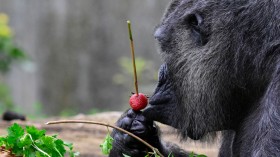In the wee hours of the morning on Aug. 7, a 30-foot juvenile humpback whale (Megaptera novaeangliae) was found trapped in the shallows near West Seattle's Fauntleroy Ferry dock.
The humpback whale was first reported at 8 a.m. during high tide, Lynne Barre, a member of the National Oceanic and Atmospheric Administration's (NOAA), Protected Resources Division in Seattle, told Tech Times.
Seattle Times reported that hundreds of people flocked to the Fauntleroy ferry terminal in West Seattle to witness the attempt to save the baby humpback whale that became stranded just 20 feet from shore.
Members of West Seattle Seal Sitters, Cascadia Research Collective, NOAA and others arrived shortly afterward to try to help the whale and keep crowds away.
Unfortunately, the whale died around 10:30 a.m
Seattle Times reported that the cause of animal's death will be investigated according to Jessie Huggins, the stranding coordinator for Cascadia. She was among several people who waded out into waist-deep water to pour water and lay wet blankets on the apparently sickly animal to keep it hydrated and comfortable.
Huggins said officials were unlikely to decide Sunday whether to tow the animal to another location for a full necropsy or if tissue samples taken from the carcass would suffice.
A humpback whale weighs 25-40 tons (50,000-80,000 pounds) with its length up to 60 feet. Females are larger than males while newborns grow about 15 feet long and weigh about 1 ton (2,000 pounds).
Humpback whales, according to NOAA Fisheries, have primarily dark gray appearance, with some areas of white. It has a lifespan of 50 years and can consume up to 3,000 pounds of food per day, with a diet of tiny crustaceans (mostly krill), plankton and small fish.
They're also known for breaching (jumping out of the water), or slapping the surface.
© 2024 NatureWorldNews.com All rights reserved. Do not reproduce without permission.

![Great White Sharks Observed for the First Time Changing Their Behavior in Different Marine Environments [Study]](https://1471793142.rsc.cdn77.org/data/thumbs/full/70251/280/157/50/40/great-white-sharks-observed-for-the-first-time-changing-their-behavior-in-different-marine-environments-study.jpg)
![Origin of Life: Discovery of Lava Being a Building Block of Life Hints 'Humans Have Volcanic Origins' [Study]](https://1471793142.rsc.cdn77.org/data/thumbs/full/70262/280/157/50/40/origin-of-life-discovery-of-lava-being-a-building-block-of-life-hints-humans-have-volcanic-origins-study.jpg)

